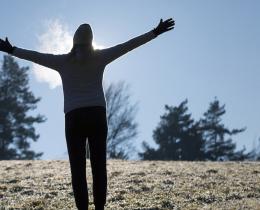Trauma-informed yoga is based on a particular understanding of trauma, one that emphasizes its impact on the entire mind-body system, as opposed to particular mental states (e.g., troubling memories) viewed in isolation from the physical body. “Trauma,” Bessel van der Kolk explains, “is not just an event that took place sometime in the past; it is also the imprint left by that experience on mind, brain, and body.”
Drawing from neuroscience, developmental psychology, and interpersonal neurobiology, this view of trauma considers body-based therapeutic methods, such as trauma-informed yoga and Eye Movement Desensitization and Reprocessing (EMDR), to be at least equal in importance to more traditional therapies, like talk therapy.
Traumatic events involve “inescapable shock”: threats to physical survival and/or psycho-emotional integrity experienced in circumstances that prevent safe escape. Traumatic events may be one-time occurrences, such as a car crash, or part of an ongoing pattern, such as chronic domestic violence.
Though single-event trauma and complex, developmental trauma differ, both evoke the nervous system response that involves the body’s instinctual fight/flight/freeze pattern, which is hardwired into the human nervous system to help protect us from harm. Normally, this provides the energy needed to propel us to safety. Trauma occurs when we are unable to take effective action to stay safe, and remain trapped in a physically threatening and/or psychologically overwhelming situation.
Balancing an Unregulated Nervous System
If we do not consequently have the opportunity to process and release the resultant sense of shock experienced throughout the body-mind system, we may remain stuck in a state of severe physiological and psycho-emotional disequilibrium. Often this manifests as hyper- or hypo-arousal.
To be hyper-aroused is to remain in a hyper-vigilant state of “high alert” regardless of actual circumstance, acutely anxious and obsessively scanning the environment for potential threats. Conversely hypo-arousal is a state of being “shut down,” feeling lethargic, apathetic, depressed, disassociated, or otherwise numbly disconnected from life.
Either way, “traumatized people chronically feel unsafe inside their bodies. The past is alive in the form of gnawing interior discomfort,” says van der Kolk. This chronic sense of dis-ease commonly produces or exacerbates additional problems, such as substance abuse, disruptive relationships, and excessive or even dangerous over-reactions to otherwise minor events. Over the long term, chronic stress and/or post-traumatic stress disorder (PTSD) may cause other serious health problems, including cardiovascular disease and diabetes.
In addition to finding ways to discharge incomplete impulses related to nervous system activation, an important part of trauma recovery is to support survivors in recognizing and responding healthfully to their current physiological/psychological state. When taught and learned from a trauma-informed perspective, yoga can be a vitally helpful resource on each of these fronts.
Yoga can have both stimulating and soothing effects. This is true on both the physical and psycho-emotional levels. Yoga teachers can encourage balance in the nervous system through classes that incorporate both stimulating and sitting postures, and by encouraging students to notice when they feel safe, soothed, and secure. Part of the skill of a trauma-informed teacher is to emphasize present-state awareness and offer opportunities for students to choose what brings them balance. Over time, students can build coping skills and make choices that support their transition from hyper- or hypo-arousal to a balanced state.
Watch for Triggers
Overly intensive reactions to more or less everyday events (e.g., unexpected loud noises) are popularly referred to as “triggers.” It is important for yoga teachers working with veterans to understand that “being triggered” is part of the pattern of physiological disequilibrium produced by traumatic experience. Yoga instructors working with veterans in clinical settings need to know why and how to adapt standard teaching practices to minimize potential triggers.
It should be emphasized that the practice of yoga may at times be triggering for some students no matter how highly trained and experienced the teacher. For this reason, teachers working with students suffering from PTSD should always have solid working relationships with support staff and clinicians.
Encourage a Multi-Pronged Approach
Understood as an experience that disrupts the mind-body system, unwinding the physiological and psychological patterns encoded by trauma may require a combination of 1) “top-down,” cognitive-based talk therapies to help process memories, strengthen relationships, and develop meaningful personal narratives; 2) “bottom-up,” body-based therapies to help calm down the nervous system, self-regulate, and feel and tolerate a range of emotions and sensations; and 3) if needed, taking medications under the supervision of a qualified professional to provide the foundation necessary for cognitive- and body-based therapies to be effective.
Trauma-informed yoga and EMDR are widely considered to be the most effective body-based therapies available. It is critical to realize that yoga will be most effective in healing trauma when it is integrated into a larger set of therapeutic supports that have been specifically tailored to the individual. Teachers should never lead students to believe that yoga is a stand-alone therapy. Even if yoga is the only therapeutic modality that a student wants to engage with, teachers should communicate that it’s always best to remain open to complementary therapies, resources, and supports.



